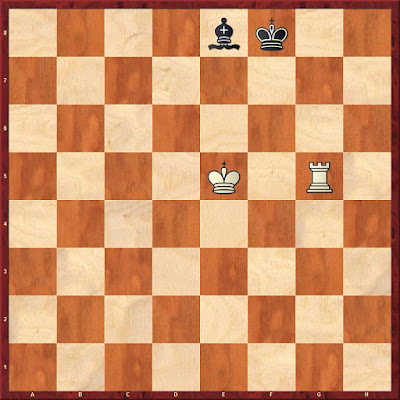Kubbel's studies are economical and practical. As he states, and Kasparian quotes:
The idea must be implemented, in the conditions of a mutual with active participation, without exception, of all pieces. Black must not wait until White fulfills his plan, but must find counrterplay, combining defense with counter-attack. All phases of this struggle--the entering into the dispute, the central stage and the end--must be connected. Each ide must be expressed using the minimum resources.The idea in one that I worked through last night did not strike me as quite as compelling as in some of the others, but playing it out against Stockfish presented me with a small problem stopping a pawn, and then offered more practice with checkmate using a bishop and knight (see "Bishop and Knight Checkmate").
As quoted in Kasparian, 888 Miniature Studies, 71.
White to move
From Kubbel, Rigaer Tageblatt 1914.
It is clear that White must win both the bishop and the pawn without exchanges.
Stripes,J -- Stockfish (iPad)
From Kubbel, 15.06.2017
1.Be4
The pin is the only move.
1...Kxa7 2.Nd5
Setting up to attack the bishop and pawn.
2...Bg8 3.Ne7
Now, Black has many possibilities. The main difficulty of this study stems from seeing from the starting position that all Black's options here fail.
3...Bh7
3...Bf7 is given as the main solution. 4.Nc6+ Ka6 5.Bd3+ Kb7 6.Nd8+.
4.Kd6 Ka6
4...Kb8 is given in an alternate solution.
5.Ke6
Comically, it was only at this point that I became fully conscious of the direction that Black's pawn moves. In a study, White always moves first and is on bottom in the diagram. However, I solve enough exercises where the board is flipped that I sometimes need to labor to focus on which way pawns move. I have failed exercises in Chess.com's Tactics Trainer because I thought pawns were moving the wrong way.
5...Kb5 6.Kf6 Kc5 7.Kg7 Kd4
White to move
I solved this exercise on my iPad three times last night, each time trying a different move here. My qust was for a more efficient capture of Black's pawn and subsequent checkmate. I saved only the third effort.
8.Ba8
I played 8.Bb1 on the first effort. Keeping the bishop on the long diagonal seems better. This idea, adopted on my second and third tries, solved the minor problem of eliminating the pawn without exchanges.
8...g5 9.Kxh7 g4 10.Kh6
10.Nf5+ is better. As the king cannot capture the pawn, it might be better to only move it towards the center. Once the pawn is eliminated, the first step in checkmate with bishop and knight is to centralize one's pieces.
10...Ke3 11.Kg5 g3 12.Nd5+ Kf2 13.Nf4
The only winning move, but easy to see.
13...Kf1 14.Kg4 g2 15.Nxg2 Ke2 16.Kf4 Kd3 17.Ne3 Kd4
White to move
18.Be4
It has become gratifying to see over and over, when subjecting my play to computer analysis, that I played the move that lead to the fastest checkmate. Alas, later on, there were some inefficient moves.
18...Kc5 19.Ke5 Kb5
White to move
20.Kd5
20.Kd4 was best. My move adds four moves to the checkmate sequence. Why is d4 the better square?
20...Kb4 21.Kd4 Kb3 22.Bd3 Kb4 23.Bc4 Ka3 24.Kc3
Efficient and correct.
24...Ka4
White to move
25.Nd5
Here we go again. 25.Nc2 was correct. My next few moves reveal that a problem remains in my execution of the bishop and knight checkmate (see "Making my Point").
25...Ka5 26.Bd3 Ka4 27.Kc4?
Adding five moves to the finish. 27.Nc7 was correct.
27...Ka3 28.Ne3 Kb2 29.Nc2 Kc1 30.Kc3 Kd1 31.Bc4 Kc1
White to move
Finally, I have reached a position that I know how to execute efficiently.
32.Ba2 Kd1 33.Nd4 Ke1 34.Kd3 Kf2 35.Ne2 Kg2 36.Be6 Kf3 37.Bf5 Kf2 38.Bg4 Ke1 39.Ke3 Kd1 40.Bf5 Ke1 41.Bc2 Kf1 42.Nf4 Ke1 43.Ng2+ Kf1 44.Kf3 Kg1 45.Kg3 Kf1 46.Bd3+ Kg1 47.Nf4 Kh1 48.Be2 Kg1 49.Nh3+ Kh1 50.Bf3# 1–0




















